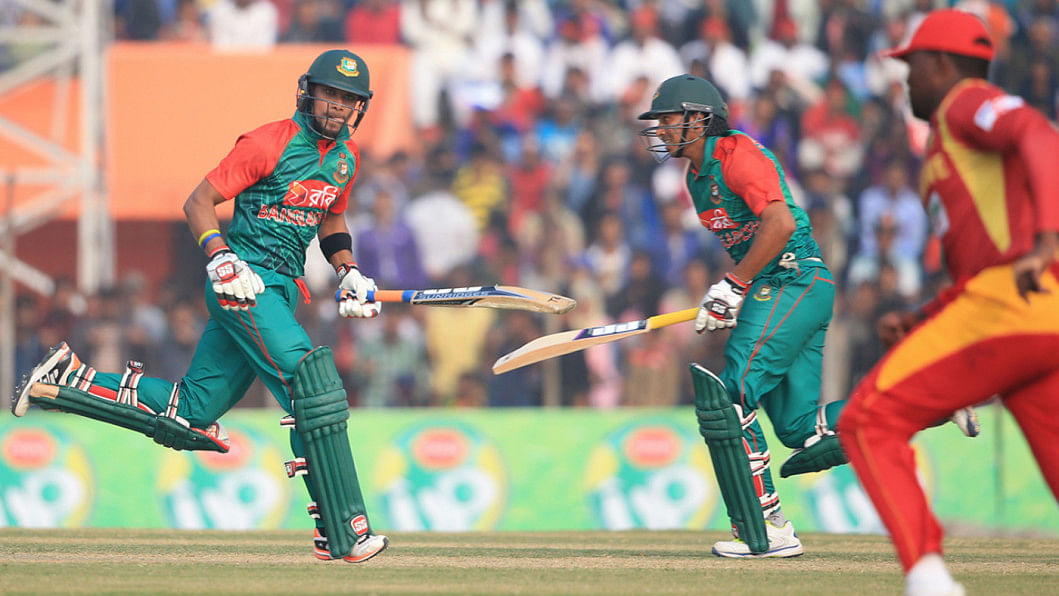Tigers look to ace the running game

Bangladesh were hardly challenged in the second T20I in Khulna as they crushed Zimbabwe by 42 runs. The win leaves them free to experiment more in the remaining two matches, with no risk of losing the four-match series. There was, however, an old problem that continued to dog the home side.
Of Bangladesh's 167 runs, 69 came in singles and twos while they scored 92 off boundaries. The opening partnership of Tamim Iqbal and Soumya Sarkar played out 18 dot balls and took eight singles in their 45-run stand that ended in 5.5 overs; they could not score off nearly half the balls they played in that stand.
At No. 3, Sabbir Rahman was at the crease for 14.1 overs but faced only 30 balls for his 43. He contributed six runs to the 30-run second-wicket partnership with Soumya and nine to the 39-run unbroken fourth-wicket stand with Shakib Al Hasan. It was only in the partnership with Mushfiqur Rahim that Sabbir got a bit more of the strike.
Against Zimbabwe in November last year, Anamul Haque's 51-ball 47 had reportedly drawn criticism from the team management, as he continued to bat at a lower strike rate. Anamul is not a part of the current T20 set-up even as Bangladesh have looked to fill up their batting order with batsmen who start quickly, in an effort to address a problem seen across ODIs and T20s.
The inclusion of Shuvagata Hom and Nurul Hasan for the first two T20s in Khulna, Sabbir Rahman's promotion, and the sidelining of Imrul Kayes from the playing XI are all indications that the coach Chandika Hathurusingha wants busy batsmen who can find gaps upon arrival at the crease.
In the last 12 months, on an average 53.7% of Bangladesh's runs have come off boundaries. In the first match of this series, nearly half of their runs came in fours and sixes. While it is key to look for boundaries in T20s, it is not the only strategy. Picking singles and twos are as vital to building a big total in T20s as they are in ODIs. So when Tamim and Soumya were playing attractive shots in the second match, the score didn't rise accordingly.
When taking regular ones and twos, a batting side ensures that the fielders are in two minds whether they should be holding back on top of the circle and at the boundary rope, or walk in to save the ones and twos. When the opposite happens, however, the bowling side always has a chance. Zimbabwe had periods of play in the second match when they tied a batsman down at one end but their own lack of experience did not help them.

Towards the end, as Shakib failed to connect many balls, it looked as if he could have given the strike back to the more set Sabbir, and this may have helped Bangladesh move past 180.
Bangladesh captain Mashrafe Mortaza said that they are focusing on improving on lack of singles in their batting approach, which he felt had to be covered through fours and sixes.
"In T20 cricket, it is difficult to play a perfect match," Mashrafe said. "There are times when singles don't come and you have to play boundaries to cover the score. But if you can take as many singles it is good, especially when the odd boundary is already coming. That's an area which we are focusing on."
Since Bangladesh are in the process of learning more about their T20 abilities, they should keep in mind the importance of taking singles and twos. Explosive batsmen are important, but these small percentages will help them stay ahead of the opposition.

 For all latest news, follow The Daily Star's Google News channel.
For all latest news, follow The Daily Star's Google News channel. 





Comments